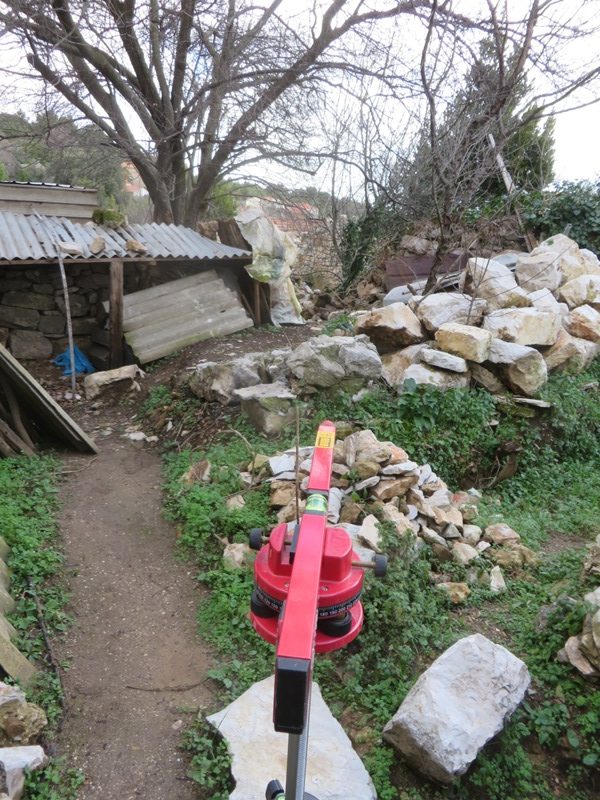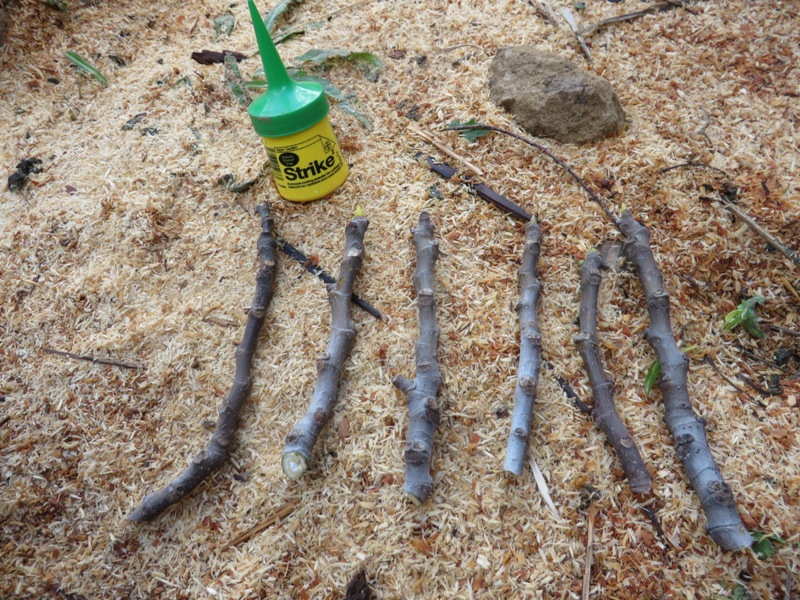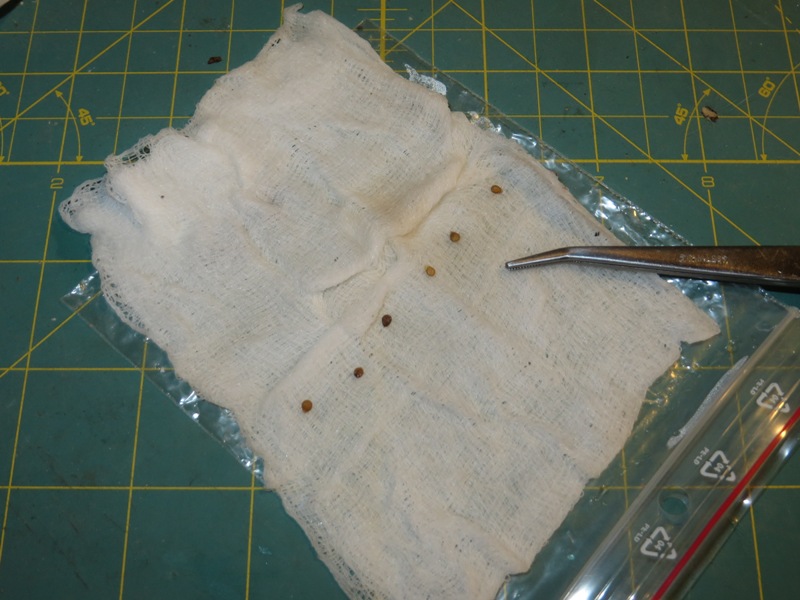Drunk with flower

This week: Wall removal; Propagating figs; Hydroponics; Weather;
The start of the week went well. With fine and mild weather I finished planting the new raspberry varieties and then tested the underground irrigation system. I’m using a microbore system to deliver water to the root area, but I need some additional connectors and will have to go to the mainland to get them.

Wall removal
Following a discussion with Toni, my builder about potential start dates for my building work, I decided I would use up the sandstone that I dug out of the courtyard, as fill for behind the steps I’m making into the orchard.
But I also want to include a rain water harvest system for the roof of the new building and this needs to be under the fill.
First job was to get the eventual finished floor level of the fold yard, so I know how deep the recovery pipe needs to be. A laser level and a measure from the top of the access hatch, which is at finished floor height was the starting point.

Then the laser was swivelled to point towards where the pipe will run.

I then transferred the measurement to my work area, marking a stone which will remain for the time being.


I began by removing the stones which supported the old boundary wall. I’ve opened a new entrance to the orchard and have used the stones to create news walls on either side. What surprised me was how rich the soil is behind the stones. It is dark and friable, and full of organic material. This is the only area of my land which has this kind of high quality soil. It should grow pretty much anything – unlike the worked out, clay and stone soils in the citrus and drupe orchards. Clearly I need to keep this soil.

It was at this point that the weather intervened. Heavy rain turned the working area to a glutenous mud. I now need a few days sunshine before I can continue.
Propagating Figs
The buds are starting to swell on the fig trees so I’ve been taking cuttings.

Everywhere here you see fig trees. They are almost exclusively Ficus carica, the Common Mediterranean Fig. However, I noticed that on a lane a short distance from my home, there is a different variety.

It looks as though it is a Brown Turkey, being much larger and a very different colour to the pale greenish yellow Ficus carica varieties I have in my orchards and I see round about.
Propagating figs is another of those “dark arts” which are only spoken about in hushed tones and taught at Hogwarts. Fig trees are said to be difficult to propagate, and if you look on line, there are any number of different ways which are proposed. One of my neighbours simply cuts a large number of 15cm cuttings, fills lots of pots with soil and then sticks the cutting into the soil.
I tried a different approach based on layering a couple of years ago which worked well, so I’ve done the same again. Using some of the very nice soil I found when removing the wall stones, I mixed in peat and sharp sand and put it into a bedding plant trough. Next I selected a number of short shoots on the fig tree, each between 12 and 20 centimeters long.

Cutting the shoot at a 45 angle, away from a leaf node, I dipped the cut end in rain water then into hormone rooting powder, before laying the cuttings flat in three rows in the plant trough. Where a cutting had a side growth bud, I laid it facing up.

The cuttings were covered to a depth of 1 centimetre with riddled soil, before I watered them. After covering the trough with cling film to keep moisture in and felines out, I put them into the greenhouse. There they are in warmth and will get some sunshine and in a few weeks I hope to see some shoots.

Hydroponics
There is a lot of energy in the sun, although sunshine has been in short supply this week.
Last year I saw an eBay advert for some small Hydroponic kits, at a very reasonable €6 each. I bought one and was surprised by the quality, so bought three more. I’d like to try some early Hydroponic tomatoes, so this week I’ve planted the seeds. I’ve visited some huge hydroponic fruit growers, but never seen small, sensible size kits for home use before.

I did wonder whether ordering hydroponic kits via eBay for home delivery would excite some interest from customs/law enforcement, but the postman cheerfully delivered the packages without incident.
My previous experience with home hydroponics was using a thermal camera while flying over some of the UK’s “interesting” public housing estates. A roof would be lit up like a Belisha Beacon, signalling “Raid me, Raid me” to anyone looking.
The instructions are comprehensive, so the first job was to select the right seeds. Fortunately I have some bush cherry tomato seeds, so I took six from the packet and soaked them in water. I soaked some clean gauze in rain water and then sealed it in a plastic bag and left it to warm over a radiator.

After two hours soaking, I transferred the seeds to the centre of the gauze, replaced it in the plastic bag and will now keep it warm on top of my UPS overnight until I see shoots.

I don’t have an airing cupboard, so will hang the bag over a radiator when the central heating is on and will move it into the greenhouse during the day. Seeds need light, heat and moisture to germinate.
Drunk with flower
Friday was another wet day, so I spent much of the day in the greenhouse.
When I was doing the re-wiring, I added a lead from a separate MCB on the Consumer unit to the greenhouse. There had been a socket there when I moved in, but the cabling was highly suspect and when I removed the socket box, it was broken and had screws missing. So this week I replaced it with a new one and connected the power up.

I needed to drill and plug four new holes in the wall, as the old ones would not hold up a Soufflé. Then I installed the socket, followed by an extension to take power to the workbench where it is needed.

The hydroponics require a timer so that once the tomato seedlings have been transferred into the hydroponic solution, the solution is properly circulated and aerated.
I built a seed propagator some time ago, but have never seemed to have the time to germinate seeds over bottom heat in spring. So now with the power installed and working, I can turn the propagator on too.
At the moment I have a number of small shrubs in the propagator. These are ones I ordered last year, which arrived in 9 cm pots. I immediately potted them on into 16 cm pots, but not wanting to plant them into their permanent position until the spring, I have left them inside.
Several have burst into flower this week. The scent from them was almost overpowering while I was working on the electrics. After several hours I think I could say I was almost intoxicated on the gorgeous scent – Drunk on flower power!
My shrubs have been chosen very carefully. I wanted plants that will survive the winter here, but more especially the summer heat. I also wanted shrubs which flower in winter, to add interest to what will be my garden area, and where possible to have a scent.
The Hamamelis x intermedia Pallida and the Sarcococca confusa – Christmas Box – not only look nice, but they give off an incredible scent and these are plants only 30 cm high.

The Christmas Box, although a little late in flowering, is covered in tiny scented ivory blooms.

When they are in their final position and have grown into two metre shrubs, I think they will completely change a dull winter garden. Certainly their scent will.
For winter colour I have several different kinds of Cornus, the Dogwood, including Cornus sanguinea also known as Mid Winter Fire or the Flaming Dogwood plant. No winter scent, but a lot of colour.

And as another horticultural experiment, I have some Bachelors Button, Kerria japonica ‘Pleniflora’.
This was a plant I had when I lived in the UK. It grew under trees, in shade, in a very dry spot and produced thousands of flowers in Spring. It also produced a lot of suckers, so I’m thinking of the future and possibly a small mail order supply of this easy to grow shrub.

Weather
As we are now into February, Veljača, and in the news there has been the record cold in central North America, coupled with the record heat across Australia, I’m pleased to say that the records from my weather station really don’t show much outside the average.
January was slightly wetter than previous years, but not statistically above the average.

The first three months of our winter cool and wet climate, have been cooler and wetter than the five year average. But five years is not an especially long analysis period, especially during this age of considerable climatic variation.
The first two weeks of January were cooler than average, but only by 1.5ºC. The last two weeks of the month have been warmer than average, but again only by about 1.5ºC. As a horticulturist what really interests me is the average winter weekly minimum temperature in winter and in summer the weekly maximum temperature. I haven’t decided when the two lines cross, but I suspect it will vary depending upon the spring and autumn precipitation rates.
Plants and trees will generally withstand heat, if their root area is moist and cold damages plants only when it is sustained. There have only been six nights since November with an air temperature below freezing this winter, and then the lowest temperature was only -1.9º C, the average below zero being around -0.9º C, so hardly cold and sufficient to damage only my least hardy sub-tropical plants, like bananas.
Trying to make sense of the voluminous data from my weather station is not easy, so this week on yet another wet morning, I used Microsoft Excel to create a different temperature graph.
We generally think of four seasons, Spring, Summer, Autumn and Winter, which in the northern hemisphere start on set dates, regardless of the location. There are local cultural norms too, for example in the UK the first day of Winter is the Winter Solstice around the 21st December. Despite the fact that in Scotland there can have been snow any time from late October onwards.
Ecologists prefer to use six seasonal groupings:
- Pre-vernal (c.1 March–1 May)
- Vernal (c.1 May–15 June)
- Estival (c.15 June–15 August)
- Serotinal (c.15 August–15 September)
- Autumnal (c.15 September–1 November)
- Hibernal (c.1 November–1 March)
Ecologically speaking, a season is a time period of the year in which only certain types of floral and animal events happen, for example the flowering of a certain type of plant.
So, if we can observe a change in daily floral/animal events, the season is changing. Here where I am in a Mediterranean (sub-tropical) climatic zone, there are changes every day. At 40º North latitude, surrounded by the relatively warm Adriatic sea Spring arrives in Dol six weeks before Europe north of the Alps.
I have started my 2019 Springwatch Phenology calendar but already have noticed that some things are later than previous years. The effect of the slightly colder December and January than previous years.

Because sometime in February is when there is a huge change in plant growth, I have started my new Pre-vernal (Spring) temperature chart then. By May our average daily maximum is above +20ºC every day, and it stays that way until mid October.
Autumn starts in September when there is a noticeable reduction in the temperatures and an increase in precipitation. Then November – Studeni in Croatian, meaning “The cold month” – is when our winter starts. So Spring apart, the seasons in Dol follow the ecological groupings.
Horticulturaly plants are divided into winter survival bands of -5ºC – 0ºC, 0ºC – +5ºC, and +5ºC – +10ºC. So when I look at potential plants, shrubs and trees, I look at the average winter minimum temperatures that they survive, but also just as importantly, their ability to survive summer heat and drought. NRC
4 Responses
Anthony Veich
Those fire bushes are the most colorful I have ever seen. I wonder if they are available in the Southwest, especially near Mesa,AZ, ? I live in the final approach path of Falcon ,Field. Where MDHelicopters is making a fortune with their new drones vis-A-vis with Boeing directly across McDowell Rd.
Irreslly enjoyresing your blog. I hope to visit you place this year where Croatia is hosting an IPA friendship week,in Split,I think .Cheers from Mesa! Mickey
Hyder
Good job
Keep working
Richard J Ellis
Mate,
You are going to be a busy puppy come springtime. Looking forward to a few “success stories” come spring/summer.
Arnulfo
Hi there! Such a good write-up, thank you!